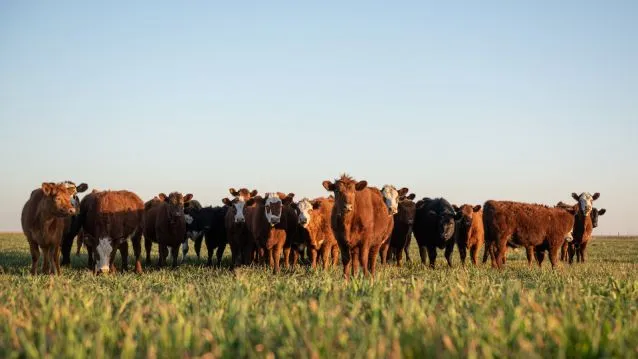The old saying, “You are what you eat,” is true and also accurate is the saying, “You are what you eat has eaten.” Let me break it down for you. If you consume fish, chicken, beef, or other meat, how that fish or meat was raised and what it has eaten during its lifetime has a direct impact on your health.
That’s right. Take beef, for example; cattle that are allowed to free-range on grass, move around under the sun, and live a stress-free life are much healthier than beef that comes from cows raised on industrial farms and fed things they should never eat. Let’s take a closer look.
The first thing that we need to do is set straight some terminology as it pertains to various types of beef.
The difference between grass-fed beef and grain-fed beef
Cows are naturally meant to graze on grass in wide-open pastures. However, with the increase in demand for meat, farmers began to feed cattle grain-based feed made from corn and soy.
The difference between grass-fed beef and grass-finished beef
Most of the cattle raised by responsible farmers graze in open pastures during the warm months, but that is not an option in the colder months when there is snow on the ground. During the winter, farmers feed their cattle feed containing corn and soy. However, since they graze for the majority of the year, they may be labeled grass-fed.
Beef that is from a cow raised entirely on grass will say “grass-finished” on the label. These animals will graze on grass during the summer and eat alfalfa in the winter. This term is not regulated by the USDA.
Is grass-fed beef also organic?
Organic and grass-fed or grass-finished beef are two completely different things. The USDA regulates the term “organic.” To be certified organic, farmers have to complete an onerous certification process that can take up to three years. Organic beef needs to be raised on a farm that does not use pesticides, genetic engineering, or sewer sludge.
In the case of beef, you can purchase organic, grain-fed beef. What this means is that cows from an organic farm were given organic feed, which includes organic corn or soy-based products. In addition, animals raised on an organic farm must live in a way that protects the welfare of the animals.
Choosing the best grass-fed beef
When shopping for grass-fed beef, look for meat that has the American Grassfed Association (AGA) stamp of approval. The AGA is a trustworthy group that guarantees that animals do not receive hormones, antibiotics, or grains.
Mahatma Gandhi once said, “the greatness of a nation and its moral progress can be judged by the way in which its animals are treated.” By his standards, the commercial meat industry in the United States points to grim flaws in our national character. However, there is good news. More and more farmers and ranchers are choosing to graze their cows, bison, sheep, and goats on ranges, where they feed on pasture grasses…just as nature intended.
As mentioned, grass-fed animals are treated humanely and fed only natural grasses, and as a result, the meat and milk that comes from these animals has significant health benefits. Most animals commercially raised for meat and dairy products in the United States come from Confined Animal Feeding Operations, also known as CAFOs. Animals that are raised in CAFOs often have no space to walk or move around at all. The stress and abuse of these conditions are truly horrifying, and many meat-eating Americans choose not to think about it, which only perpetuates the cycle of mistreatment.
Health benefits of grass-fed beef
Known as a nutritional powerhouse, grass-fed beef has numerous health benefits that make it well worth the extra you might have to pay.
- Grass-fed beef helps balance blood sugar levels – When you enjoy beef from cows that have grazed on grass, you reap the benefit of the fatty acid CLA (conjugated linoleic acid). This fatty acid has been found to reduce the risk of several diseases and conditions, including obesity and diabetes. In one randomized, double-blinded study, it was found that 37% of people given CLA had better insulin sensitivity when compared to those who were not given CLA. Insulin sensitivity helps to promote healthy blood sugar levels.
- Grass-fed beef is a potential cancer fighter – There are 16 different types of CLA. Each of them has a unique health benefit. In research studies, CLA has been found to be a cancer-fighting food. In one study that was published in the journal Nutrition and Cancer, researchers discovered that women who had the highest levels of CLA in their diets also had a lower risk of breast cancer when compared to those without CLA in their diet.
- Grass-fed beef can boost your immune system – Grass-fed beef is rich in bioavailable vitamin A that is vital for growth, reproduction, vision, and a healthy immune system. Heme iron, found in grass-fed beef, is also important for a strong immune system, sexual function, and the production of stomach acid. Beef from cows fed grass also contains B12 that helps keep nerves, blood cells, and DNA healthy. The vitamin K2 found in grass-fed beef is good for your heart, blood vessels, and bones.
- Grass-fed beef can reduce the risk of heart disease – The CLA found in grass-fed beef has been shown to reduce the risk of heart disease. Because this type of meat contains less unhealthy fat than beef from cows fed grain, it can help promote a healthy heart. It also contains less dietary cholesterol, high levels of heart-healthy omega-3 fatty acids, and heart disease-fighting antioxidant vitamins, including vitamin E.
Grass-fed cows are happy and healthy cows
As stated earlier, cattle that are allowed to range freely on grass are generally happy cows that are not crammed into tight spaces where disease can run rampant. Almost 80% of antibiotics sold in the United States go to conventionally raised livestock like beef. Sadly, as the demand for meat skyrockets, farmers crowd animals into smaller and smaller spaces where they can get sick easily. Using antibiotics in meat causes antibiotic resistance in humans. Additionally, grain-fed cattle have acidic intestinal tracts that can cause issues like E. coli, which can be fatal in people who eat undercooked beef.
According to Consumer Reports research:
“One of the most significant findings of our research is that beef from conventionally raised cows was more likely to have bacteria overall, as well as bacteria that are resistant to antibiotics, than beef from sustainably raised cows. We found a type of antibiotic-resistant S. aureus bacteria called MRSA (methicillin-resistant staphylococcus aureus), which kills about 11,000 people in the U.S. every year, on three conventional samples (and none on sustainable samples). And 18 percent of conventional beef samples were contaminated with superbugs — the dangerous bacteria that are resistant to three or more classes of antibiotics — compared with just 9 percent of beef from samples that were sustainably produced. We know that sustainable methods are better for the environment and more humane to animals. But our tests also show that these methods can produce ground beef that poses fewer public health risks.”
Raising cows as they should be raised is good for the planet earth
Not only is grass-fed beef good for your health, but it is also good for the environment. Research shows that traditional grass-based beef production can help decrease greenhouse gas emissions, create a diverse ecosystem, and improve the quality of run-off water from pastures where cows graze. In short, raising cattle as they were meant to live creates a much smaller footprint, and unlike conventional cattle farming in tight quarters, it brings much good to the earth.
Keep in mind that moderate consumption of meat is recommended. A good rule of thumb is to treat meat like your side, not your main dish.
-The Alternative Daily


